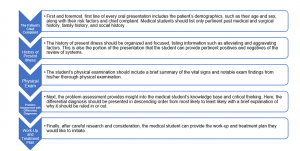Alyka Glor Fernandez
The Emergency Department (ED) is busy. Resident and attending physicians are occupied every minute of their shifts with patient care, procedures, orders, and charting. In addition, they are responsible for teaching and supervising medical students who rotate in the ED. While our responsibility as students in the ED is to learn the basics of emergency medicine, we can also be valuable team members. In particular, medical students can facilitate patient care by obtaining and delivering accurate and concise patient presentations.
Most of a medical student’s training on patient presentations is taught through pre-clinical courses and their clerkship rotations. While the basics of presenting a case are similar across specialties, the ED patient presentation is unique. Davenport et. al outlined the key differences between EM and other specialties in their paper titled, “The 3-Minute Emergency Medicine Medical Student Presentation: A Variation on a Theme.” They advise medical students to approach every patient case with four tenants in mind (Figure 1).

Figure 1 summarizes the four tenants to approaching ED patients discussed in the Davenport et al. article.
Dr. Zack Olson, MD of the podcast, EM Clerkship, argues that the oral presentation is the most important skill a student must master in any clerkship in order to excel and impress residents and attending physicians. Dr. Olson, MD, Dr Davenport, MD, and their colleagues outline the key components of an EM oral presentation (Figure 2).

Figure 2 summarizes the key components of an EM oral presentation.
It can be overwhelming for medical students to have to learn a new way of thinking and structuring patient presentations specific to EM. It is important for patient care in the ED, but reflective of a student’s understanding of basic emergency medicine. Dr. Dhimitri Nikolla, DO, a former ACOEP-RSO President and an attending emergency physician, comments:
“A long presentation with irrelevant details or a short presentation lacking important information tells me that the student may not fully understand the differential diagnosis, work-up, and/or treatment.”
As with all skills in medicine, practice is the key to success. Of course, it is important to ask for feedback from preceptors, but it is equally important to pay close attention to the resident and/or attending when they interact with the patient. See how they elucidate information from the patient that you may have missed or misunderstood. Watch them examine the patient and you might learn a new test or technique. As you evaluate and treat more patients, you will inevitably have more opportunities to learn.
To learn more information about patient presentations in EM, I encourage you to read and listen to the resources below.
Resources:
Davenport C, Honigman B, Druck J. The 3-minute emergency medicine medical student presentation: a variation on a theme. Acad Emerg Med. 2008 Jul;15(7):683-7.
Olson, Z. (Host). (2016, March 27). Patient Presentations [Audio podcast]. Retrieved from https://open.spotify.com/episode/4GWgmRuQLo73SsDi8NKswM?si=cRRDy6WMQeiwlnmYgwlDrA.
